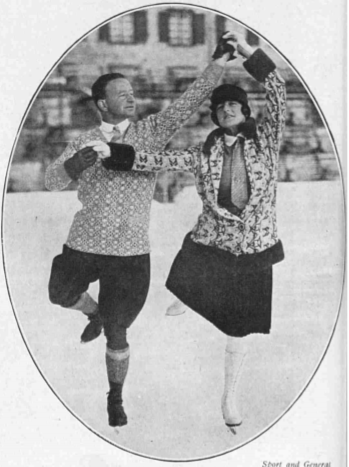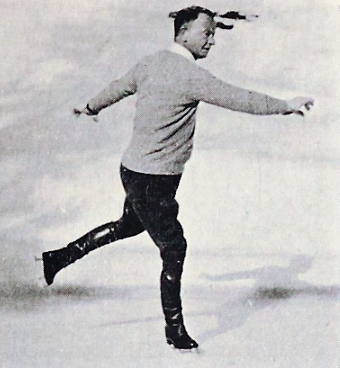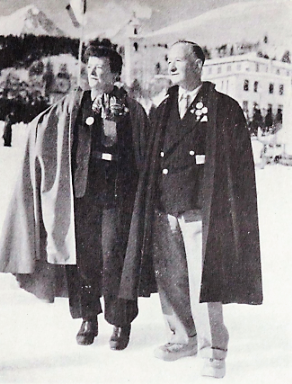"Captain T.D. Richardson is to British skating something of what Vaughan Williams is to music and Bernard Shaw to literature. He combines the knowledge and wisdom of a vast experience with a tireless, almost youthful zest for progress." - Dennis Bird, "Skating World" magazine, September 1952
The son of James and Catherine (Cameron) Richardson, Thomas Dow (T.D.) Richardson was born on January 16, 1887 - the year of Queen Victoria's Golden Jubilee - in Yorkshire, England. He was the youngest of the couple's six sons and two daughters and spent his early years in the family's large home on Bishopshill Road. The household he grew up would have been bustling with activity, as his aunt and grandmother as well as a live-in servant lived with his parents and siblings. His father was a hosier and sub postmaster.
T.D. - or 'Tyke' as he was later nicknamed for his York upbringing - first took to the ice in 1891 during The Great Frost... an unseasonably cold winter that froze over waterways and fens alike and made for optimum skating conditions. As a young man of fourteen, he and brother Alexander attended a small private school called Grosvenor Mount School in Scarborough, Yorkshire run by Herbert Walton and boarded with the Offord family in South Kensington. He later attended a private school in Lausanne, Switzerland.
On October 21, 1905, at the age of eighteen, T.D. was enrolled in Cambridge University and admitted to Trinity Hall. By this time, his father had sadly passed away. While attending the university, he proved himself quite a sportsman, excelling at boxing, rowing, bandy, curling and golf. Alexandra Browne, the College Archivist and Records Manager at Trinity Hall, noted that his successes as an oarsman: "He was in first boat for the May Bumps and Henley boat races 1907-1909, and he won the Ellis Pairs in 1908." Though short in stature, T.D. competed in wrestling matches against Oxford in two different weight classes.
In the autumn of 1906, T.D. found himself in court, charging with "using obscene language" towards a police officer. He entered a plea of not guilty and his defense stated it was a case of mistaken identity. The judge dismissed the case due to insufficient evidence. It was the only blot in an uneventful academic career. Mary Scott of the Cambridge University Archives noted, "He worked towards the Ordinary B.A., that is without honours, sitting both parts of the general examination in 1908 and 1909. The subjects examined will have included the Acts of the Apostles in Greek, a Latin classic, a Greek classic, algebra, elementary statics, and elementary hydrostatics and heat. Thereafter, we have no records of him sitting any further examinations and he does not appear to have graduated."
As was the fashion at the time, T.D. regularly wintered in Switzerland as a teenager, where he added skiing and bobsled to his list of athletic pursuits. He first learned to figure skate in the stiff English Style, taught by Captain Roy Scott Hewett (who would later hold the British title in this style several times) in Grindelwald. After earning his bronze medal in the English Style, he was introduced to the Continental (International) Style of skating by Bernard and Alex Adams in 1905. At first he thought it was "rather vulgar". He recalled, "By this time the 'English' was on its last legs, although it is true that when I and my friends came down from Cambridge 'to eat dinners' at the Inner Temple, and went during the day to skate at 'The Toxophilite' in Regents' Park, where 'The Skating Club' functioned we were requested to wear 'morning coat.'"
Through careful study of the methods of the Adams brothers, Bror Meyer, Ulrich Salchow, Gustav Hügel and many other greats of the era, he successfully transformed himself from a rigid English Style skater to an adept Continental one and soon earned his gold medal in the latter as well. Sir Samuel Hoare recalled, "His counters and rockers go off on the ice like pistols, his brackets are as infallible as the Pope, and not only does he know the reason, but he can describe it to other people." Through his friendships and mentors in Switzerland, T.D. soon became so passionate and educated about the sport that he developed a unique interest in the sport's technique and history and an uncanny ability to impart his knowledge on to others.
Mildred (Allingham) and T.D. Richardson
Back home in England, T.D. could often be found on the ice at Prince's Skating Club and the Hammersmith Ice Rink. A year after his mother passed away, he began skating with Mildred 'Wag' Allingham at Prince's. The on-ice couple, who won three cups in ice valsing together, soon became an off-ice one, marrying in 1915. Then, like so many other young British men at the time, T.D. went off to fight in World War I. After serving on the Western Front and earning the rank of Captain, he returned to Great Britain and took up permanent residence in a hotel with his beloved wife, who he referred to as "his accomplice".
Illustration of Mildred (Allingham) and T.D. Richardson at the 1913 British Championships
T.D. and Mildred attended the 1928 Winter Olympic Games in St. Moritz, where he served as Great Britain's judge in the women's event. At those Games, Papa Henie asked T.D. to take a look at Sonja's figures. Without batting an eyelash, T.D. informed him that she couldn't skate brackets at all and proceeded to show her how to do them. Papa asked Tyke to coach her, and he flatly refused... because he was judging her. Papa Henie offered him a case of champagne, and then a motor boat, which he refused. Finally, he suggested that his former coach Alex Adams (who was teaching at Suvretta House) offer her some instruction. Mildred, who acted as interpreter between Sonja Henie and Adams recalled, "She adored Tyke. He was the only person to whom she ever listened or was able to tick her off."
In the early thirties, "Modern Figure Skating", his first of almost a dozen books on figure skating technique and history, was published. A copy translated into Japanese served as a training manual for Kazuyoshi Oimatsu and Ryuichi Obitani, the two young Japanese men who became the first from their country to compete in the Winter Olympic Games in 1932. Over the years, he also penned articles on figure skating for "The Westminster Gazette", "The Field", "The Daily Telegraph", "Country Life", "Skating Times" and "Skating World". He even contributed to the "Encyclopedia Britannica." During the thirties, T.D. supplemented his income from writing by managing a company called International Film Renters Ltd.
Mildred and T.D. at the Kulm Rink during the 1948 Winter Olympic Games
As chef de mission of the British Olympic team in 1936, he was wined and dined by Nazi officials - including Jaochim von Ribbentrop - at buffet suppers and banquets. Twelve years later, while serving as Chief Of The Foreign Press at the 1948 Winter Olympic Games in neutral Switzerland, he had to reach out to the office of his old Cambridge University classmate Hugh Dalton, when the British Olympic team arrived without uniforms for the opening ceremony. He got the money for uniforms... no small miracle as clothing was still on ration for coupons back home in England at the time.
Skaters at an amateur ice show in St. Moritz, Switzerland. Left to right: Ursula Barkey, Valerie Hunt, Peter Burrows, Joan Haanappel, Anthony Holles, Joyce Coates, Mildred 'Wag' Richardson, David Clements, T.D. 'Tyke' Richardson, Catherine Morris, Michael Robinson, Diana Clifton-Peach, Anne Reynolds, Barbara Conniff
Following the 1948 Winter Olympic Games, T.D. received a two year suspension from the ISU for "journalistic activities" when he broke strict but controversial rules about participants (both skaters and officials) publishing any commentary of international competitions. Because the rules didn't apply to "writing of books on figure skating", they became dubbed the "Richardson rules". At the 1949 ISU Congress in Paris, the ISU clarified these rules, stating "No judge, official or competitor of the ISU, taking part may write. If not taking part they may write but must not receive any payment." T.D. fired back in "The Skating Times", writing, "So that a man or woman, whatever his or her integrity or ability may be, is barred by his profession from assisting in international competitions!"
In 1956, the ISU finally decided that T.D. was a "non-amateur" and therefore allowed to write about what he pleased. Though some perceived his roles as an author and journalist for "Skating World" and "The Times" and judge and referee for the National Skating Association as a conflict of interest, T.D. developed many strong bonds over the years. His many famous friends included Howard Nicholson, Claude Langdon, Gustave Lussi, Jacques, Arnold and Hans Gerschwiler, Gladys Hogg, The Brunet's, John Harris, Theresa Weld Blanchard and Gillis Grafström.
Photo courtesy Elaine Hooper, BIS Archives
T.D. served as chairman of the National Skating Association's Ice Figure Committee from 1945 to 1948, 1950 to 1955 and 1965 to 1966, the founder and chairman of the NSA's Technical Advisory Committee. Over the years, he made several important changes to England's testing schedule, including the introduction of pair tests to his country. He also helped found the NSA's Ice Dance Committee and advocated for the introduction of 'new' compulsory figures (three-rocker-threes, bracket-counter-brackets and double loops) to the ISU schedule. These 'star tests for advanced figures' were suggested by T.D. back in the thirties, but not introduced through the NSA until 1967.
Michael Booker recalled, "Around 1954 T. D. Richardson approached me about learning new figures... I did learn some and demonstrated them to leading UK teachers and judges. About eighteen months later again at a judges school in Davos conducted by Arnold Gerschwiler and 'Karly' Enderlin, Arnold's bosom friend (Arnold made a special farewell trip to Switzerland to see Karl just a month before he, Arnold, died.) As I recall most of the figures were three circle jobs, rockers and counters with brackets and threes on the end circles and a double brackets figure; in order to accomplish the latter the 'push/pull' method had to be used on fairly small circles to keep the pace and get back to the center. They were an interesting challenge but not really that difficult, certainly no more than left back loop change loop! One of the main reasons they were rejected, and I forget how many there were, was economic, a practice ice issue. There being no Zambonis, patches lasted two hours and were always at a premium. These new figures simply took up too much ice and time and were too impractical except for the most skilled skaters; an attempt was made to include them in the schedule to no avail."
One of the reasons, perhaps, that T.D.'s 'new' compulsory figures didn't gain a lot of traction over the years was the fact that he often butted heads with ISU officials and took digs at the ISU in his writings. In 1947, the ISU introduced a rule that empowered the referee of a competition to immediately kick any judge who was caught communicating with a spectator "by sign, signal or otherwise" off the panel and out of the competition. With his characteristically dry wit, T.D. wrote in "The Skating Times": "What fun! I hope I am there when some gallant referee has a crack at enforcing this new one.. There will be no complaint of the dullness of school figure skating on the day when some wild partisan forgets to be a good boy." He italicized the ISU's admission that "this might be difficult to enforce", highlighting the absurdity of such a cop-out to their own rule.
With Claude Langdon, he formed the Sports Advisory Committee of Britain, whose members included the Duke of Hamilton, Lord Aberdare and Cyril Tolley. He also conceived and played an instrumental role in organizing the Commonwealth Winter Games and taught Sir Samuel Hoare how to skate. "If he helped me," Hoare wrote, "he has helped scores of others. There is not a skater at the Suvretta rink at St. Moritz who does not owe him a debt of gratitude for the word of advice and encouragement that he is always ready to give. Who that has seen him at work will forget the spectacle of his judging a test? I think of him surrounded by a crowd of keen skaters, scanning the tracings as a detective would follow blood stains, congratulating success, condoling with failure."
In January of 1955, Queen Elizabeth II bestowed upon T.D. the Order Of The British Empire (OBE) for his many contributions to figure skating in Great Britain and twelve years later, the National Skating Association honoured both him and Mildred with honorary lifetime memberships. Benjamin T. Wright, chairman of the ISU Technical Committee and ISU Referee, ISU and USFSA historian, recalled, "He was a good guy. He and his wife were an interesting couple... a power couple." NSA historian Elaine Hooper recalled, "I was quite a young skater when he was around and he was always around in an ice rink somewhere and were a bit frightened and also in awe of him. He was very involved with the elite skaters at the time." The late Cecilia Colledge once said, "He acted always for what he knew was right. He would not submerge his principles in order to be popular. He would not compromise in order to be elected. He would not curb his independent courage. He served skating."
T.D. Richardson passed away on January 7, 1971 at his home in Kensington just over a week before his eighty-fourth birthday, not long after undergoing a major operation. Shortly after T.D.'s death, skating historian Dennis L. Bird wrote, "'T.D.' was not an easy man to work with, and never concealed his impatience with anyone who disagreed with him. Many of the beneficial changes which he introduced in figure skating met with considerable opposition, partly because he was not always very diplomatic in dealing with official organizations. He was never deterred by controversy [and] was a gifted man in many ways... In reviewing championships for the press - technical as well as national - he was seldom harsh so far as individual skaters were concerned, preferring to show them how to improve in future rather than to criticize their present abilities. (Occasionally, however, he could be devastating in what he did NOT say.) But if he spared the feelings of competitors, he had no patience with judges who did not know their job. He wrote of one European championship panel 'Some of the judges were obviously ill-instructed in the fundamentals... They cannot be expected to be able to appreciate the fine points...' In private he could even more pungent... Old in years, he was perennially young in outlook. It was characteristic of him that, in one of his last official speeches, at the 1967 NSA Ball, he urged the importance of having more young skaters involved in running the NSA. When the NSA Presidency became vacant some years ago, it would have been a fitting honour to bestow on him. But when his views were sought on a possible 'back-bench' move to put his name forward, he did not at his age want to be involved in a contest (another greatly-respected skater had already been nominated). And in a sense the office would have added little: his place in skating history was already assured; his life's work done. He may have been physically small of stature, but he was a... towering personality in the small world of figure skating."
Photo courtesy "Skating" magazine
T.D. was elected posthumously to the World Figure Skating Hall Of Fame five years later in 1976 and to this day, his books and articles remain one of the most important windows on skating history that exist. Simply put, without T.D. Richardson the world of figure skating wouldn't be what it is today.
Skate Guard is a blog dedicated to preserving the rich, colourful and fascinating history of figure skating. Over ten years, the blog has featured over a thousand free articles covering all aspects of the sport's history, as well as four compelling in-depth features. To read the latest articles, follow the blog on Facebook, Twitter, Pinterest and YouTube. If you enjoy Skate Guard, please show your support for this archive by ordering a copy of figure skating reference books "The Almanac of Canadian Figure Skating", "Technical Merit: A History of Figure Skating Jumps" and "A Bibliography of Figure Skating": https://skateguard1.blogspot.com/p/buy-book.html.













